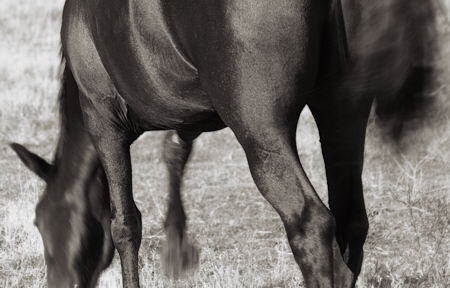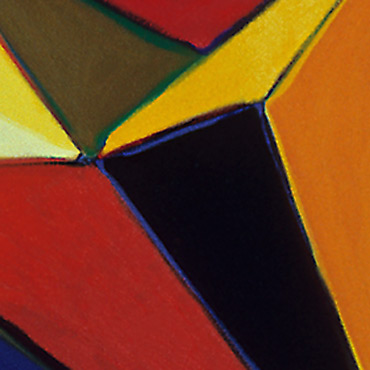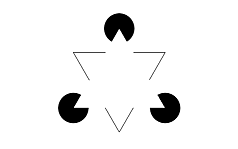
Recent posts here on the topic of edges and their sharpness (or not) have been finding echoes in other places. For example, I’ve just read the intriguing but peculiar short story by Balzac, entitled The Unknown Masterpiece, which I learned of by reading that Picasso was asked to illustrate an edition. He (P) was apparently fascinated enough that he rented a studio in Paris thought to figure in the story; that’s where he painted Guernica.
In the Balzac story, the master painter Frenhofer says the following regarding edges:
I have not marked out the limits of my figure in hard, dry outlines, and brought every least anatomical detail into prominence (like a host of dunces, who fancy that they can draw because they can trace a line elaborately smooth and clean), for the human body is not contained within the limits of line. In this the sculptor can approach the truth more nearly than we painters. […] A line is a method of expressing the effect of light upon an object; but there are no lines in Nature, everything is solid. We draw by modeling, that is to say, that we disengage an object from its setting; the distribution of the light alone gives to a body the appearance by which we know it. So I have not defined the outlines; I have suffused them with a haze of half-tints warm or golden, in such a sort that you can not lay your finger on the exact spot where background and contours meet. Seen from near, the picture looks a blur; it seems to lack definition; but step back two paces, and the whole thing becomes clear, distinct, and solid; the body stands out; the rounded form comes into relief; you feel that the air plays round it.
Thus, for Frenhofer, nuanced edges are simply facts of physical reality, and hence, in a painting, reflective of greater artistic skill in holding the mirror up to nature. Of course, the argument applies better to organic, rounded objects than to manufactured, hard-edged ones.

Detail from Untitled, Laurie Fendrich 1985
I was also reminded me of some statements by the elsewhere mentioned painter Laurie Fendrich about soft vs. hard edges in geometrical abstraction:
Most “geometric abstract painters” are also “hard-edged.” I was already not hard-edged. Instead, I liked including a soft touch in these paintings. Up close, you can see the interstices between the triangles carrying a lot of previous coats of paint. I was infatuated with that kind of underlying revelation that a painting can give a viewer. It’s certainly fun to paint that way—to leave traces of what happened before—and I remain infatuated with leaving traces of what’s underneath the top layer even today.
…
To me, the lovely leftovers of underlying painting layers are beautiful to look at if you get up close to a painting. And I like the halo or echo that these edges create from a distance.
The notion of realism is more or less irrelevant in this context, but nonetheless there is a kind of distinction between natural and artificial. Now it relates to the process rather than the subject, the imperfect (by hand) vs. the precise (by tool).

Perhaps it’s not surprising that edges can play a significant role in our appreciation of an artwork. Edge detection is one of the most prominent mechanisms of perception that allows us to identify distinct objects, i.e. segment the visual field. It is so powerful that it can be easily led into various illusions. For example, the impression of edges of the Kanisza triangle, even within the white spaces, refuses to go away, despite our rational conviction that there are none.

Steve,
There clearly is a challenge to invent something new.
The challenge may be to paint or photograph motifs that SUGGEST edges such as the ones in the Kanisza triangle!
Off to a busy day, more later.
Discarding the color from Laurie Fendrich’s painting suggests that it is not so much about edges but about differences in light and darkness of the large geometric areas.
Can the same be said about the horse picture?
I am off up North for a well-deserved long weekend.
Birgit:
But some might say that that is one definition of an edge – a defined boundary between differences. Makes me think of Ellsworth Kelly.
For me, the color is essential to the Fendrich, and I find the treatment of the edges to also be important. I don’t think I’d find it interesting if there were simply hard boundaries between the triangles.
Another geometric abstract artist whose rougher edges (in the paintings) I like is Sharon Butler. I came across her and others on Joanne Mattera’s blog, which also has a recent post on Vibrational Geometry with op art images that out-Kanisza Kanisza for optical effects. I remember having a large jigsaw puzzle of a Richard Anuszkiewicz painting that was incredibly difficult.
The horse picture was chosen for having both hard and soft edges, in this case due to motion. Not only is the edge quality different, but also the still/sharp body is much more sculptural and solid, while the blurred head/neck seems flatter.
Steve,
What a wealth of differing ideas about edges you have found. The Balzac/Frenhofer/Picasso quotes and connections are amazing.
I was most interested in the “edges” within the horse shape — rather like a zebra if one squints a bit. I think I’ll have to explore squinting further in a post (to come soon, honest).
And re: reality — Richard Schmid (“Alla Prima”) says, “If we ignore edges, our work will be flat and unconvincing. Remember, I am referring here only to painting that attempts to create an _illusion_ of an individual’s ordinary visual reality. Virtually all other ways of painting, while unquestionably valid in terms of artistic license, are deviations from, or changed versions, of nature.”
And Birgit, Schmid says that edges and value (“differences in light and darkness”) really come close to being the same thing.
More later.
For many years I’ve been attracted by the notion of the ‘all over’ in painting , consequently the ‘edge’ was no longer the point at which the painting stopped but had become more & more an element which needed to be integrated into the composition. For Kelly the edge, in a sense , became the composition; for Olitsky, during the 60’s and 70’s, the edge was nearly a raison d’etre in his work. (‘Walking the edge’ implies risk, the risk of falling, coming apart at the seams. Thinking of Bach’s fugues.)Recently I’ve started using curves in a series of two colour paintings – keeping in mind Bach ; trying to keep the momentum going; trying to find a way around Kelly. The edge – the damn edge, the space between what is and what ceases /changes; the no-thing which makes sense of the some-thing. If anybody is interested to see how flat I’ve fallen on my face there are few examples on :
tony-fromhere.blogspot.com
Enjoyed the post & the comments very much. Thankyou.
Folks:
It would seem that this topic might be category-friendly, in that I can enumerate types of edges. The list might include the imposed or acknowledged limits of the “active field” of a work, the Ellsworth Kelly kind of thing, the Marca Relli, the edge as understood in a cubist context, as an active bifurcater (knife), that which marks the boundary of a given set of rules, etc.
Edge as an ‘interiorising/exteriorising’ element; where the painting ends the ‘real’ begins and even though the painting may use a notion of ‘reality’ as its subject its ‘true’ reality lies in its quality as object, not as a depiction of ‘reality’. Dear God, I’m in a mess with all these words & single inverted commas – forgive me – but I have always been attracted by the equivalence between verbal paradox and visual ambiguity without ever having the intellectual capacity to fathom the thing out.
I am trying to figure out to paint moving EDGES, seen as the crest of waves in water.
Birgit:
Could you explain that a little more?
Dear Birgit, Just a thought – Very small, close hued dots (as pointilisme)would diffuse the line and open up the possibility of playing on the interaction between colours.
You guys are too fast. I go away to do a little research on Ellsworth Kelly and Marca-Relli and you’ve moved again.
Anyway, I’m not sure about the relation between the notion of edge as I had been thinking of it (edge of a shape, or even a line-like twig) and edge as the boundary of whole picture. It seems there may well be a connection in a fundamental sense, or maybe just as an association of ideas. Tony, were you explicitly relating those two notions, or is it just you were thinking more in terms of picture edge/boundary?
Regardless of how we got there, I do find tony’s investigations as shown on his blog (be sure not to miss the Older Posts link at the bottom) quite fascinating. It is definitely something I’m also thinking about in terms of cropping horse’s bodies, as in the image at top.
I tend to think of “allover” paintings as ones essentially ignoring the picture boundary (e.g. Pollock’s Lavendar Mist), as opposed to classic representation that composed within the boundary, or abstraction like Kelly’s that clearly referred to and used the boundary. Tony’s work seems to be pointing at the boundary by pointing beyond it with shape edges that run into the picture edge. Though abstract, it implies something cut off as in photographic cropping. I think this concern is very separable from Tony’s other main concern, the interaction of colors. Tony, do you see it that way? What is the relation for you among shapes, their edges, picture edges, and color? I guess that’s a pretty big question, but I’m interested in any thoughts you care to give us on the subject.
I’m with Steve — a surfeit, delightful yet overwhelming – of info. And I just looked at Birgit’s post with the edges of waves — another, slightly different, surfeit.
Tony, some of your shapes appear to curve a bit at the edge of the canvas. Is this an illusion or do they really do so? The “curve” makes me think they extend beyond the canvas — or perhaps it’s the reverse — the extension gives me the illusion that the lines curve.
I was also fascinated with Marc-Relli, whose late work falls into the Pattern and Decor style. That “style” (or maybe it was a movement) uses edges in a very different way than Tony or Ellsworth Kelly. Those edges set up a rhythm, whereas Tony’s edges (forgive me for intruding on your work, Tony) feel to me like large drum bursts or a keening trumpet. For that matter, Birgit’s edges in the water are more rhythm, but they change time signature in irregular/regular ways.
Steve, there’s definitely a connection between the edge of a leaf within a painting and the edge of the canvas — a thorny connection that has been poked at often. The reason the Ab Exes (like Pollock) painted so large is they wanted to go beyond the peripheral vision, so there would be (at least if you were in the correct position in front of the painting) no edge within sight. All that you could see would be the color and shape the painter controlled.
This is wildly different from conventional photography (not yours, Steve) where the picture is totally elsewhere, outside the self. It’s probably why large-scale photographs are now all the rage — they are an attempt to force the viewer into the scene, confronting the edges within the canvas without the distance that the outside of the canvas would give one.
Tony, how big are your paintings?
Dear Steve & June, I was very touched by your kind reaction to the images on the blogsite and I will do my best to answer your questions. For decades I worked only with horizontals and verticals – I didn’t really understand how to use a curve which came neither from nature nor geometry. Some time back I took the decision to start incorporating curves into a series which I called ‘Mass & Dynamic’. I have tended to work in series, not for any dogmatic reason but rather because with my grasshopper mind I need to impose some sort of discipline on myself. The “Mass’ referred both to the area that each colour took up & was loosely associated with the idea of different ‘weights’ of colour. Dark brown being heavier that cerulean blue which in turn weighs less cadmium orange. The ‘Dynamic’ element came from the ‘speed’ of the line and the chromatic speed of the colour. (Loosely expressed & pretty subjective.) What I used as a guiding idea in making this series is that all things in nature seem to seek a point of ‘harmony/balance’ but since all is transient such a point is rarely if ever achieved. What I was after was suggesting an ‘anxious balance’; the touching point between affirmation and denial where opposing elements almost become one. I do small drawings first and from the composition comes an idea of which colours I will use. Originally I used high value colours but that again was a question of discipline. Having had a few exhibitions this year I am now reducing down the colour dynamics because when 5 or more paintings are together there is just too much visual activity going on. As to scale again it’s a very fluid situation. Originally I intended to work up to 1.50m. x 2m. but it soon became evident that anything on that scale becomes more ‘architectural’ than domestic so now I am quite happy thinking in terms of 50cms. x 70cms. or 1m. x 1m. for those images which are closer to the square. In answer to your question, June, as to whether or not the shapes curve a bit at the edge the answer is ‘yes’ they do. In this way I try to pull the edge into the composition. I try to avoid the suggestion that the paintings ‘continue’ beyond the canvas edge(hence the ‘denial’ element). I apologise for having gone on so long but I hope there is something in this jumble of words.
tony,
Thanks for your thoughts. I find the notions of “mass and dynamic” and “anxious balance” very evocative. I think they’ll help me see things with a new eye.